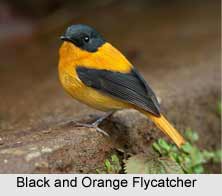 Black-And-Orange Flycatcher is an Indian bird that bears a scientific name "Ficedula nigrorufa" is a species of flycatcher endemic to the central and southern Western Ghats Mountain Range in India, the Nilgiris Mountain Range, Satpura Mountain Range, and Palni hills ranges in southern India.
Black-And-Orange Flycatcher is an Indian bird that bears a scientific name "Ficedula nigrorufa" is a species of flycatcher endemic to the central and southern Western Ghats Mountain Range in India, the Nilgiris Mountain Range, Satpura Mountain Range, and Palni hills ranges in southern India.
Uniqueness of Black-And-Orange Flycatcher
Black-And-Orange Flycatcher is unique among the Ficedula flycatchers in having rufous coloration on its back and prior to molecular studies was suggested to be related to the chats and thrushes.
Concentration of Black-And-Orange Flycatcher
Black-And-Orange Flycatcher is a distinctly coloured bird found mainly in the high-elevation areas of the Western Ghats Mountain Range in India, the Nilgiris Mountain Range, Satpura Mountain Range and associated hill ranges.
Structure of Black-And-Orange Flycatcher
The male Black-And-Orange Flycatcher is distinctly black headed with black wings. The female Black-And-Orange Flycatcher has the black replaced by dark brown and has a light eye-ring. Black-And-Orange Flycatchers are usually seen singly or in pairs.
Colour of Black-And-Orange Flycatcher
The young Black-And-Orange Flycatcher at around two weeks of age is brownish orange with a whitish vent and abdomen. The head has dark streaks and the wings appear bluish with a trace of brown. There is a pale ring around the eye and the orange tail appears stumpy. Eight weeks after fledging they appear almost like adults except for patches of brown feathers in the crown.
Habitat of Black-And-Orange Flycatcher
The main population of Black-And-Orange Flycatcher is found in the high elevation plateaus (above 1500m) areas of the Nilgiris Mountain Range, Palani Hills, Biligiriranga Hills, Chamarajanagar District, Karnataka and its adjacent mountain range (Bellaji and Honnametti) and Kannan Devan Hills. Black-And-Orange Flycatchers prefer areas with high leaf litter and undergrowth in open shola grassland habitats.
Behaviour of Black-And-Orange Flycatcher
Black-And-Orange Flycatcher is a highly parochial bird and no local movement other than dispersal of young has been noted. To the north, it occurs in the Kudremukh National Park and the Bababudan Hills and south to the Ashambu Hills. Some old records of the species from Maharashtra and Sri Lanka have been considered dubious.
Breeding Season of Black-and-orange flycatcher
In the breeding season of Black-And-Orange Flycatcher, the March to May, these birds are very vocal and they have a repetitive "chee-ri-rirr" or a whistling song "whee-chee-ree-rirr". They feed on insects by fly catching low over the ground (under 2m height) and also pick insects from the ground.
Nests of Black-And-Orange Flycatcher
The nest of Black-And-Orange Flycatcher is built by the female, placed in a low bush or fern. Two greyish speckled eggs form the usual clutch. Young birds are brownish and speckled. The nest is unlike that of most flycatchers and is large, coarse, ball-like and made from sedges. The nest has a foundation of dry leaves and ferns. The nest has an external diameter of about 6 inches (15 cm) and the egg cavity which is devoid of any lining is about 2 inches (5.1 cm) in diameter and 2 inches (5.1 cm) deep. The nest is placed usually at the centre of a bush at about 1 to 3 feet (0.30 to 0.91 m) height with an entrance hole close to the top.











